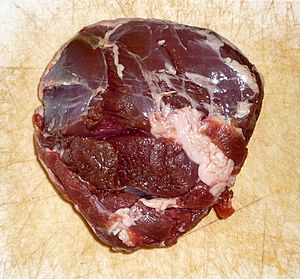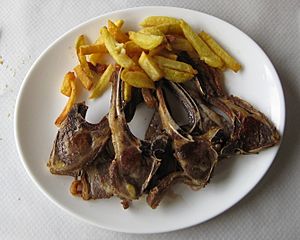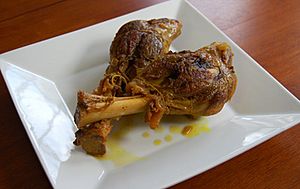Mutton facts for kids
Lamb, hogget, and mutton are all types of meat that come from sheep. The main difference between them is the age of the sheep when the meat is taken.
Lamb is meat from a very young sheep, usually less than one year old. It's known for being very tender and having a mild flavor. Hogget comes from a sheep that is a bit older, usually between one and two years old. Mutton is meat from an adult sheep, typically over two years old. Mutton has a stronger taste and is often tougher than lamb.
In many places, especially in recent years, you'll mostly find "lamb" sold in stores. Sometimes, even meat from slightly older sheep might be called lamb. Mutton, with its stronger flavor, is harder to find in some areas.
Contents
What's the Difference?
The names for sheep meat can change depending on where you are in the world. Generally, younger lambs give smaller, more tender meat. Mutton, from older sheep, is less tender. You can often tell the age of the meat by its color: baby lamb is pale pink, while regular lamb is pinkish-red.
Lamb, Hogget, and Mutton Ages
In countries like Australia and New Zealand, a lamb is a young sheep under 12 months old. Its meat is very tender.
Hogget is a term for a sheep that's a bit older, but still young. Its meat is often sold as "lamb" in places like the UK, even though it's technically hogget.
Mutton is meat from an adult sheep, usually over two years old. This meat is tougher and has a stronger flavor.
In the United States, the terms "hogget" and "mutton" are not very common. Most sheep meat, regardless of age, is simply called "lamb." Sometimes, very young sheep meat is called "prime lamb."
Mutton in India

In countries like India, the word "mutton" often refers to goat meat, not sheep meat. For example, if you order "mutton curry" there, it will almost always be made with goat meat. This is because there are many more goats raised for meat in these regions compared to sheep.
Cooking Sheep Meat
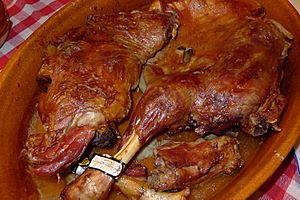
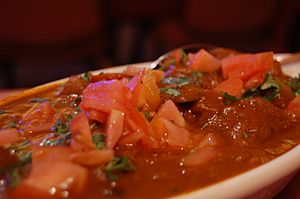

Hogget and mutton have a stronger taste than lamb. Some people prefer this stronger flavor! Because mutton and hogget can be tougher, they are often best cooked slowly. This includes methods like casseroles or stews, where the meat cooks for a long time and becomes tender. A famous example is the British dish Lancashire hotpot.
Lamb is often divided into three main parts for cooking:
- The forequarter includes the neck, shoulder, and front legs.
- The loin is the middle part, including the ribs.
- The hindquarter includes the back legs and hip.
Lamb chops are popular cuts that come from the rib, loin, or shoulder areas. They are often grilled. A leg of lamb is a whole back leg, which is usually roasted.
Meat from the forequarter, especially from older sheep, has more connective tissue. This means it's best cooked slowly using moist heat, like braising or stewing, or by slow roasting.
Lamb shanks are cuts from the upper part of the leg. They are often cooked slowly until they are very tender.
In Western Kentucky, USA, barbecued mutton is a traditional food. This tradition started because the area had a lot of older sheep from the wool trade that needed to be used for meat.
Cuts of Lamb
Different countries have slightly different ways of cutting lamb. Here are some common cuts:
Common Cuts in the UK
- Scrag end (of neck)
- Middle neck
- Best End (of neck)
- Loin
- Chump
- Leg (sometimes called gigot)
- Shank
- Shoulder
- Breast
Common Cuts in the US and Ireland
- Square cut shoulder (for roasts and chops)
- Rack (for rib chops)
- Loin (for loin chops or roasts)
- Leg (for sirloin chops or leg roasts)
- Neck
- Breast
- Shanks (front or back)
- Flank
Images for kids
-
Lamb shanks cooked on an open fire in Aroab, Namibia
See also
 In Spanish: Carne de oveja para niños
In Spanish: Carne de oveja para niños


